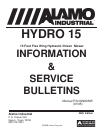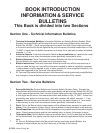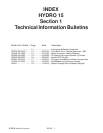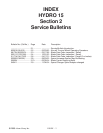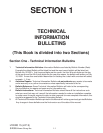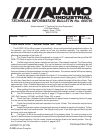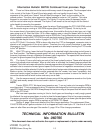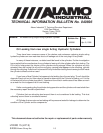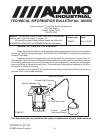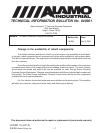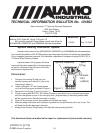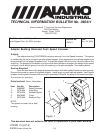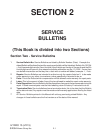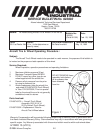
© 2005 Alamo Group Inc.
1-3
HYDRO 15 (HY15)
Information Bulletin 060795 Continued from previous Page
TECHNICAL INFORMATION BULLETIN
No. 060795
This document does not authorize the repair or replacement of parts under warranty
10. There is a Valve attached to the tractor within easy reach of the operator. The three spool valve
is for control of the Hydro 15 level lift and wing angle, with one handle for each wing. Two
segments of the valve have "detent" that will allow the wings to "float" on the contours of the
ground surface. The other valve segment is spring loaded to center on "off" position. This valve
segment is connected to the level lift system. The Hydro 15 may be raised to transport height
and the control valve may be released. The Hydro 15 will remain at the set height until the control
valve handle is moved by the operator.
11. Move the mower to a clear area, lower the wings. Slowly engage the PTO (540 RPM) control
with the tractor engine running at 1000 RPM engine speed (Not PTO Speed). Do not try to set
the mower down in the material you are going to mow, this would be like trying to start your car in high
gear going up a hill. Start the Hydro 15 in a clear mowing area or raise the mower (with the level lift
system) up out of the grass. Increase tractor engine RPM to the Tractor Manufacturers recommended
engine speed to produce 540 PTO RPM, then you may begin mowing. Operators instruction and trouble
shooting guide may be found in section 4, pages 10, 11 & 12. CAUTION ! Tractors now have a "brake"
on the PTO Shaft. If the tractor RPM is above idle when the PTO is disengaged, excessive strain is
placed on all components of the drive system. Therefore the only correct procedure to use when
disengaging the PTO is to reduce the tractor engine speed to an idle before moving the PTO handle
to the "off" position.
12. With PTO turning , lower the level lift system to the desired height, place wing control levers in
the "float" position. The Mowing ground speed will vary and can be determined by the conditions of
the area, roughness of terrain, vegetation thickness, type of vegetation. The operator will have to select
the gear for ground speed that gives the best mowing job.
13. The Hydro 15 has a relief valve on each of the three hydraulic motors. These relief valves will
emit a high squeak when activated. When a relief valve is activated the forward progress should be
stopped. If the relief valve was activated the forward progress should be stopped. If the relief valve was
activated due to excessive forward ground speed for the amount of vegetation encountered, a lower
gear of tractor should be selected. If relief is activated due to foreign material becoming entangled in the
blade or carrier, the foreign material must be removed after the mower has been completely shut
down and tractor engine has been turned "off". Use the proper procedure to secure the tractor so it
cannot be started until all work is done and every one is clear.
14. Use the owners manual / parts book to keep a record of the maintenance records on the Hydro
15. Daily and weekly sample forms are found in section 5, pages 2 & 7.
NOTE:
Tractor RPM & PTO, We have heard operators say, "I run my tractor at a low engine RPM to
save the engine". This is erroneous thinking! The tractors are designed for continuous operations at the
rated PTO shaft speed of 540 RPM. Always keep the tractor running at the speed that will result in 540
RPM at the PTO shaft.
We have seen operators running in third or fourth gear and traveling on really rough ground
throttle back the engine speed down in order to slow the forward speed, this isn't a proper procedure.
The proper procedure is to shift the tractor to a lower gear that will give a slower ground speed while
maintaining the tractor engine RPM to maintain a 540 RPM PTO Speed.
Section 5, page 3 has exact details of the filter change procedure. Two replacement filters,
P/N 00751529 and a 5 gallon container of oil is shipped with each new Hydro 15. Use this oil to refill
reservoir after filters are changed. See section 5, page 12 for Filter change procedures.



